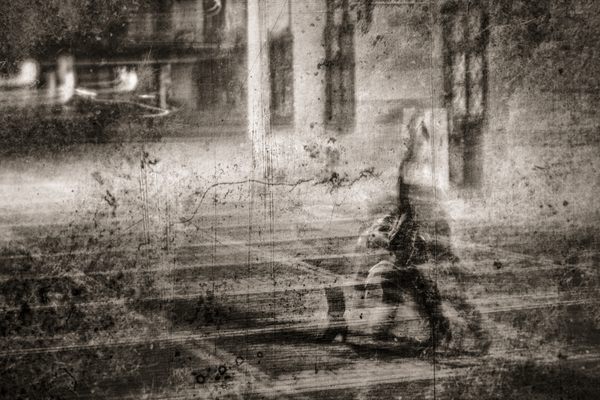Inns to Die For: Murder Hotels of America
Children’s room in the Villisca House (photograph by Jennifer Kirkland)
On a summer night just over a century ago, two adults and six children where bludgeoned to death while they slept in the sleepy town of Villisca, Iowa.
Josiah and Sarah Moore had returned home from a special evening service along with their four children, as well as two of their daughters’ friends. Mary Peckham, who lived next door to the Moores, stepped out early next morning to hang her laundry and noticed that her neighbors hadn’t let out their chickens. Sensing that the house was unusually quiet, she called Josiah’s brother, who unlocked the house. He only had to go as far as the parlor to see that terror had struck his brother’s home.
The forms of two small bodies rested beneath blood-soaked sheets.
“It sent the town into a panic,” said Johnny Houser, who now offers tours of the house where this bloody 1912 crime took place.
“Crime in small town Iowa was very uncommon,” he explained via email. “Especially to a family who had no known enemies.”
A state senator, traveling preacher, and known serial killer were all suspected of the crime, but no culprit was ever convicted of the murders despite a five year long investigation.
That’s what makes the Villisca House so compelling decades after the blood stains have disappeared.
Ina & Lena Stillinger were friends of the Moore children. They stayed the night in the house after a church service & were found dead in its guest bedroom the next morning. (courtesy Villisca Ax Murder House)
The Moores (photograph by Jo Naylor)
“People hate the fact that it’s unsolved,” Houser stated. “This poor loving family deserves justice and many who visit want to piece together the clues and sort of solve it themselves.”
Although evidence at the crime scene — including two hunks of bacon found on the floor of the home — was tampered with as the townspeople converged on the house, the site retains much appeal for those interested in true crime mysteries.
“Some come for only history while others come for ghost stories,” Houser says. “The crowds are of all walks of life from doctors and homicide detectives to college students and bikers.”
Tours of the house, which has been restored to look as it did in 1912, are available offered year-round except during the winter. A small group of guests can stay overnight in the house for just over $400.
The Villisca Ax Murder House (courtesy Villisca Ax Murder House)
The house has a special appeal for those interested in the paranormal. One such visitor wrote in a testimonial on the Villisca House website:
I believe the spirits of all eight victims still dwell within that house. The burning question is, ‘Why?’ Is it due to fear and trauma as a result of the incident itself or is it because that house is the last place they knew? Or all of the above? […] I believe there are many secrets embedded within the town of Villisca concerning the axe murders that may never be revealed.
There are American inns thought to be haunted from the Red Garter, a former bar and bordello in Williams, Arizona, where an old call girl — Evie — is said to lurk, to the Historic Farnsworth House in Gettysburg, Pennsylvania, which is thought to be crowded with the ghosts of Confederate solders and those who cared for them. But few sites in stand out in macabre hotel lore like the Lizzie Borden House.
The 31-year-old Lizzie Borden was arrested for killing her father and stepmother — Andrew and Abby Borden — in their Fall River, Massachusetts home in 1892. The two were murdered in a manner similar to the Moores and their guests: thrashed in the head with repeated hits from a hatchet.
Exterior of the Lizzie Borden House (photograph by David/Flickr user)
Lizzie Borden Bed and Breakfast (photograph by Pamela Bohnenstiehl)
The killing of this wealthy couple sent shockwaves through the community, and although at the time few women had stood trial for such violent crimes, Lizzie was taken in as the prime suspect. This was not only because of her embittered relationship with her stepmother, but also because she was said to be hugely frustrated with her father’s frugality.
Visit the Lizzie Borden Bed and Breakfast today, and you may meet co-owner and manager Lee-Ann Wilber, who often gives tours of the house. Standing in the room where Abby was bludgeoned, Wilber tells guests:
She was facing her attacker. When her attacker came into the room, she turned and faced him, so she knows who killed her. We know this because the first blow to her face was on the left side, just by her ear. She went down. The killer, whoever they were, then straddled the body, delivering 18 more hits. Seventeen to the side of her head crushed her skull and one caught her between the neck and the shoulder blades.
Wilber has taken care to reconstruct the two rooms where the murders occurred based on crime scene photographs, which are displayed to give visitors a sense of what took place within the very walls where they stand. The room where Abby was killed is among the most popular, she said over the phone from the Borden B&B.
The John Morse Room, where Lizzie Borden’s stepmother was killed (photograph by Pamela Bohnenstiehl)
Inside the Lizzie Borden House (photograph by Amy Meredith)
Replica skulls of the victims (photograph by Amy Meredith)
Tours are offered several times a day to cover the history of the site, with a focus towards the otherworldly in the evenings. Wilber explained that she prefers to let visitors form their own opinions.
“I want the guests to come up with their own theories as the story’s being told,” she said. “I don’t want to interject too much of my own personal reasoning and personal theory until we get to the end.”
But Wilber does have her own take on the matter: “Personally, I think [Lizzie] was involved. If she didn’t commit the crime herself, she has to know who did, because of the layout of the house.”
The house is a traditional Victorian-era home, but with a series of locked doors between rooms and two separate staircases which would have made it difficult, Wilber argues, for someone unfamiliar with the house to find and murder two residents, all while one them — Lizzie — was inside.
“You can look at drawings of its layout,” Wilber said, “But you can’t really put it into perspective until you’re actually standing in those rooms.”
Second floor plan (via Guy F. Wicke)
Many who have an interest in the case come to see how easy it might have been for suspects to move through the home, but there’s just as many, of course, who are there to convene with those killed as well. Many are eager to get a clearer sense of the vexed Lizzie, who was eventually acquitted of all charges against her. She returned to live for a short time in the house where the murders occurred, but was treated as a social pariah by much of the town which felt certain of her guilt.
“There’s so many angles [that] we’ll never know the truth of what happened,” Wilber says. And in that way, the Lizzie Borden House, the Villisca House, and others are almost doubly haunted — not only by what occurred in them, but by the mystery that still hangs over them all these years later.
Lizzie Borden’s House (photograph by Kimberley Jones)
Find more curious and unsettling accommodations on Atlas Obscura >
















Follow us on Twitter to get the latest on the world's hidden wonders.
Like us on Facebook to get the latest on the world's hidden wonders.
Follow us on Twitter Like us on Facebook